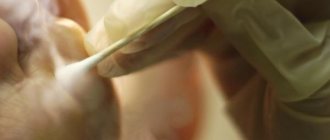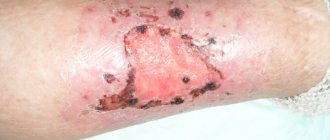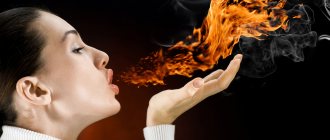Causes of laryngeal burns
Burns of the larynx are a destructive process that develops in the larynx under the influence of thermal or chemical factors. Damage usually affects not only the larynx, but also the oral cavity, oropharynx and epiglottis, trachea and bronchi. There are not many
causes of burns to the larynx Burns of the larynx are never asymptomatic. They are accompanied by the following reaction from the respiratory system:
- swallowing disorder (dysphagia);
- hoarseness, hoarseness, or complete loss of voice (dysphonia);
- breathing problems or complete impossibility due to swelling and inflammation of the burned surface;
- secretion of mucopurulent sputum, often mixed with blood, and sometimes (in case of deep burns) with elements of necrotic tissue;
- the development of shock and respiratory arrest is likely.
Signs of a burn at different stages
Doctors also classify all chemical and thermal burns of the throat according to severity. This helps to provide first aid correctly and prescribe appropriate treatment. These include:
1st degree:
- the surface layer of the epithelium is damaged;
- a person experiences swelling and redness in the oral cavity and mucous membrane;
- you may feel a sensation of pain and burning in the throat;
- The patient's condition is not deteriorating, but is in a stable condition.
2nd degree:
- a person develops specific blisters that contain gray films;
- 2 weeks after receiving a burn, plaque begins to separate;
- the wounds begin to heal and heal, forming scars at the burn sites;
- the person feels slight weakness for 2 weeks after the injury;
- It is allowed to increase body temperature to 38 degrees.
3rd degree:
- it is characterized by signs of intoxication;
- burned areas die off;
- scabs appear;
- ulcers form;
- the functions of the pharynx, larynx, and esophagus are impaired.
How to treat burns of the larynx?
Treatment of burns of the larynx should begin before the arrival of an ambulance, the call of which in this case is absolutely impossible to avoid. First aid measures include washing the throat and stomach with several glasses of lemon juice or vinegar diluted with water (1:1); if the burn is caused by acids, then in the same way it is necessary to use solutions of magnesium carbonate or table soda. To lavage the stomach in an amount of 3-4 liters, a solution of water and milk (2:1) is used.
In a hospital setting, the patient is prescribed analgesics, broad-spectrum antibiotics, corticosteroids and cardiac medications. Etiotropic therapy in this case should be combined with symptomatic treatment.
Since the natural intake of nutrients and fluids into the body is difficult and sometimes impossible, the patient undergoes massive transfusion therapy, parenteral nutrition and nutritional enemas, and blood transfusions are performed.
In some cases, with increasing cases of shortness of breath, a tracheotomy may be prescribed, and in order to prevent the formation of scars, a long period of bougienage is indicated.
First aid
A favorable outcome in treatment will depend on the speed of assistance, the nature and degree of mucosal burn. Initially, it is established what could have caused the injury. To do this, a visual examination of the room is carried out, the presence of a specific odor of the substance that caused the burn is taken into account.
If this does not give any result, then you need to examine the wound and the patient’s mucous membrane, carefully examine the vomit and the type of scab.
If the burn was caused by interaction with alkali, then the vomit will contain pieces of mucous tissue. When injured by iodine, they turn blue or brown. After a burn, a scab appears, the color of which can tell a lot:
- with acid burns it is yellow, that is, the injury occurred due to nitric or hydrochloric acid;
- for black - sulfuric acid, for white - hydrogen peroxide.
Once the agent that caused the burn has been accurately determined, measures can begin to eliminate the effect of this chemical. There are rules that should be remembered and followed immediately after a throat injury.
If the injury occurred as a result of boiling water or hot liquid, then the injured person should be given a glass of cold water to drink. To relieve pain, you need to give novocaine or lidocaine.
When injury occurs from various acids, it is necessary to give a lime mixture.
For alkaline burns - diluted citric acid.
The person must be provided with antiseptics and given a flow of fresh air.
If the burn is quite serious, it is necessary not to waste time, but to take the victim to the hospital, where doctors can quickly provide qualified medical care.
Treatment of other diseases starting with the letter - o
| Treatment of obstructive bronchitis |
| Obesity treatment |
| Treatment of herpes zoster |
| Treatment of adrenal tumors |
| Treatment of tracheal tumors |
| Treatment of ARVI |
| Treatment of orchitis |
| Treatment of osteoarthritis |
| Treatment of osteomyelitis |
| Treatment of osteoma |
| Treatment of osteoporosis |
| Treatment of osteochondrosis |
| Treatment of osteochondropathy |
| Treatment of acute abdomen |
| Treatment of acute intestinal failure |
| Treatment of acute mesenteric ischemia |
| Treatment of acute renal failure |
| Treatment of laryngeal edema |
| Treatment of otitis media |
| Treatment of pityriasis versicolor |
The information is for educational purposes only. Do not self-medicate; For all questions regarding the definition of the disease and methods of its treatment, consult your doctor. EUROLAB is not responsible for the consequences caused by the use of information posted on the portal.
Treatment methods
All further measures aimed at a speedy recovery will depend on how badly the throat is damaged. If doctors have diagnosed severity levels 2 or 3, then the patient must be treated in a hospital where qualified care will be provided. With severity level 1, restoration of the mucous membrane can occur at home; the main thing is to observe the following measures:
- Mandatory pain relief. You can take tablets or special solutions.
- Use valerian and bromine as sedatives.
- Treatment with antibiotics to minimize the spread of infection or infection.
- In order for the wound to heal faster and all functions to be restored, you need to infuse oil-based preparations with a special syringe.
- To reduce the level of intoxication, it is necessary to administer a solution of glucose, hemodez, rheopolyglucin.
- Gargle with antiseptic agents to prevent the development of further throat infections.
For the most severe and complex injuries, surgery may be prescribed. Most often, surgical intervention is needed in cases where scars or ulcers begin to form. Usually they begin to greatly interfere with the normal functioning of the body. Therefore, operations are performed on the trachea, larynx, and esophagus.
What not to do
If damaged mucous membranes are treated incorrectly, recovery will take a long time, resulting in an increased risk of infections and other health problems.
People who accidentally burn their throat should follow their doctor's recommendations. In this case, it is prohibited:
eat hot foods; eat solid foods; drink alcoholic beverages; smoke; To talk loudly; come into contact with harmful chemicals, even if protective measures are used.
To quickly restore the mucous membranes of the throat, you must follow these recommendations and the advice of your doctor. The prescribed procedures must be followed.
Burns in the throat can be effectively treated with a universal infusion, which should be in every home medicine cabinet.
Degrees of burns
Burns, depending on the severity of the injury, are divided into 4 degrees:
- First. The mucous membrane turns red and slight swelling is possible. The pain is mild, there is only a slight burning sensation and discomfort during talking and eating. This type of injury goes away in 2–4 days.
- Second. The palate, gums, lips or tongue become covered with small blisters. When they burst, they reveal an ulcerated surface. The pain is intense, changes, plaque, and bleeding are visible on the mucous membrane. Unpleasant sensations persist for up to 2 weeks.
- Third. The deep layers of tissue are injured, and partial necrosis of the oral mucosa is noted. Scabs and bleeding ulcers form on damaged areas. Inflammation of the palate can take up to 2 months to heal.
- Fourth. It is characterized by the death of superficial and deep tissues, including nerve endings. Because of this, the patient may not feel pain. This type of lesion is extremely rare.
Chemical burns must be treated by a doctor.
Important! Typically, thermal burns occur only in the 1st and 2nd degrees. Stages 3 and 4 are typical for chemical injuries.
Possible complications
1st degree burns to the throat are considered minor. They do not pose a serious threat to health and life and pass quickly, since the mucous membranes have a high level of regeneration. But 2nd and 3rd degree burns can lead to complications. They can cause not only disability, but also death.
Common consequences of 2nd and 3rd degree burns are the following:
the appearance of large scars on the mucous membranes of the larynx, esophagus and pharynx; intoxication of the body; shock, collapse; suffocation resulting from swelling of the mucous membranes; reflex cessation of breathing when nerve endings are damaged.
The risks of complications from throat burns are high. And to prevent their occurrence, if you get injured, you should immediately call an ambulance.
Symptoms
A throat burn can be recognized by the following symptoms:
- sharp pain that intensifies when swallowing;
- attacks of nausea and vomiting;
- hiccups;
- burning in the throat;
- increased salivation;
- hyperthermia.
- The spread of the burn to the trachea and larynx is accompanied by coughing and shortness of breath. The voice disappears or becomes hoarse. Bubbles appear against the background of reddened, edematous walls. The lymph nodes are involved in the process.
In severe cases, patients feel a strong burning sensation in the stomach and behind the sternum. The lips swell, cardiac activity worsens, the pulse becomes weak, and blood pressure decreases. Then the body temperature rises.
During this period, esophageal bleeding occurs. Laryngeal edema often develops with suffocation. The patient can die within 1 week from burn shock, collapse, or cardiac arrest.
Clinical picture ↑
Symptoms depend on what kind of substance the burn was caused by and the severity of the burn. For example: sulfuric acid causes a white scab that turns brown or black over time. Hydrochloric and nitric acid provokes the appearance of a yellow scab. In some cases, an odor may be observed from the injured tissue.
THIS IS REALLY IMPORTANT! Right now you can find out a cheap way to get rid of a sore throat... FIND OUT >>
Regarding the degree of damage, there are three of them; the following symptoms may be observed when examining the larynx:
first degree, characterized by uneven whitening of the mucous membrane; by the third day, rejection of the affected tissue begins to be observed. General intoxication, as a rule, is not observed;
the second degree has signs of general intoxication of the body, lesions of varying extent are observed on the mucous membrane. A week after the injury, scabby tissue is rejected with the formation of erosion, there are no scars;
the third degree is the most complex, severe intoxication occurs with fever, vomiting, tissue necrosis and the appearance of ulcers and subsequently scars, arrosive bleeding is possible.
The main symptoms of burns are as follows:
- sharp severe pain in the larynx;
- increased salivation;
- temperature increase;
- burning sensation;
- swelling of the mucous membrane;
- feeling of lack of air;
- dyspnea;
- nausea with vomiting.
Symptoms shown
If a person burns his throat, he immediately experiences a feeling of severe pain in the throat. Moreover, not only the throat hurts, but the tongue and all the soft tissues of the larynx hurt. In this case, the pain syndrome can be supplemented by the following symptoms:
heavy salivation; burning throat; enlarged cervical lymph nodes.
If the pharynx is injured, signs such as fever, nausea and vomiting may appear. If the mucous membrane is severely burned, shock may occur, in which the person falls into a stupor and may even lose consciousness.
When viewed externally, a burned throat looks like one big red ball when viewed from the inside. The mucous membranes turn red, swell, and have a pronounced vascular network. The general condition of the patient depends on the degree of the burn received and its type.
Preventive measures
A burn to the pharyngeal mucosa is often the result of simple carelessness. And to prevent such injury from occurring, you should take precautions and be careful.
Adults should never leave small children unattended. If your baby is formula-fed, try formula before giving him a bottle. It shouldn't be hot.
Do not leave boiling water, detergents or other chemicals within reach. They can only be stored in places inaccessible to children.
Work with harmful chemicals only in protective clothing. And you can use medications and alternative medicine only after consultation with a specialist, observing dosages and proportions.
How can you burn your throat?
Substances such as:
- hot food, liquid or steam;
- alcohol and alcohol tinctures;
- acids in high concentration;
- ammonia;
- concentrated iodine solution;
- concentrated hydrogen peroxide;
- alkalis;
- liquids used for cleaning plumbing, washing floors, cleaning pipes;
- battery fluid;
- Lugol's solution.
Based on what caused the damage, there are two types of burns - thermal and chemical.











